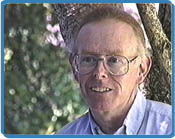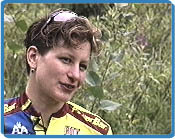|

|
|
Aerodynamics
Page: 2 of 2
|
|
Drafting
Drafting is an important technique in road racing. Exploratorium
Senior Scientist Paul Doherty explained, "The bicyclist, as he moves
through the air, produces a turbulent wake behind himself. It makes vortices.
The vortices actually make a low pressure area behind the bicyclist and
an area of wind that moves along with the bicyclist. If you're a following
a bicyclist and can move into the wind behind the front bicyclist, you can
gain an advantage. The low pressure moves you forward and the eddies push
you forward."
|


|
The Exploratorium's Paul Doherty talks about drafting.
|
|
|
Suprisingly drafting not only helps the bicyclist following
the leader, but the lead cyclist gains an advantage as well. Paul explained,
"The interesting thing is by filling in her eddy you improve the front
person's performance as well. So two people who are drafting can put out
less energy than two individuals (who are not drafting) would covering the
same distance in the same time." While the lead cyclist gains some
advantage in this situation she still needs to expend much more energy than
the cyclist who is following.
In road racing, bicyclists group together in a pack known
as the "peloton" or a pace line called an "echelon."
Cyclists who are part of the group can save up to 40 percent in energy expeditures
over a cyclist who is not drafting with the group. To be effective drafting,
a cyclist needs to be as close as possible to the bicycle in front of him.
Many professional cyclists get within inches of the the bicycle in front
of them. The shorter the distance the larger the decrease in wind resistance.
|
|
Le Tour de France: The Great Race
Aerodynamics play a huge role in the biggest bicycle race in the world,
the Tour de France. Covering over 4,000 kilometers in three weeks of daily
racing, "The Tour" is an all-out test of riders' speed, strategy,
and heart. Cyclists travel mostly in a pack, called the "peloton,"
which creates a huge draft. In each day's "stage," the racers
test themselves against each other and against the mountainous terrain of
the Alps and the Pyrenees. Stages can last for six to eight hours, covering
90-150 miles (145-240 km), and racers can burn over 10,000 calories a day.
The winner is the rider with the lowest total time for all stages. As 1988
Tour champion Pedro Delgado put it, "This is the war of the cyclists.
That's what we call it."
Though the climbs in the Alps and the Pyrenees are arduous, the vicious
crosswinds that play across the fields of France mean that the flats offer
little respite. A lone cyclist can be battered to a standstill. In these
conditions, the peloton strings out into a diagonal paceline formation called
an "echelon." Like a paceline, this diagonal line of riders is
designed to let the lead riders fight the wind, while following riders are
sheltered, awaiting their turn at the front. When an echelon forms, its
length is limited by the width of the road, resulting in a fierce battle
in the "gutter" for the final places in the echelon line. Since
the riders in the echelon have a 15-30% advantage in the wind, a failure
to make the first echelon can be the difference between a chance to win
the stage and a long futile chase.
|
|
|
In mountain biking, drafting seems to be less important. U.S.
cross-country champion Ruthie Matthes explained, "In mountain biking,
drafting doesn't tend to be a factor. The speeds are slower (than road racing)
and the rolling resistance is greater. It helps to draft for the mental
aspect, for keeping pace with someone ahead of you. But as far as using
less energy, it's not really a big factor." Besides the rolling resistance
and slower speeds, the twisting up-and-down nature of most mountain biking
courses would make drafting extremely difficult.
|


|
Ruthie Matthes discusses drafting in mountain biking.
|
|
|
Recumbents and HPVs
Drafting is not always an option and its benefits are somewhat
limited. The easiest way to overcome wind resistance and reduce drag is
to become more streamlined. In recumbent design, the cyclist pedals from
a seated position, which gives the bicycle a lower profile and makes it
aerodynamically more efficient. Recumbent bicycles have been around for
over 100 years, although they have never enjoyed the popularity of the upright
safety bicycle, which remains the design people associate with bicycles.
|
|
Human-powered vehicles became popular during the the 1970s.
During that decade the popularity of the bicycle reached a new high and
two OPEC oil embargos increased public awareness of alternative methods
of transportation. Most HPVs use a recumbent design and a lightweight outer
shell to make the vehicle more streamlined and to reduce skin friction.
HPVs can travel at very high speeds. The world record holder in the 200
meters traveled at over 68 miles per hour (110 km).
|

|
A custom-made recumbent cycle.
|
|
|
Recumbents hold many speed and endurance records and are quite
comfortable to ride. Recumbents are so efficient that many races do not
allow recumbents to enter for fear that the cyclists on the traditional
safety design will be at a disadvantage. There are a few disadvantages to
the recumbent design. One is the cost; recumbents are not mass-produced
and cost more than safety bicycles. In addition, recumbents are harder to
see on the road--most use an orange safety flag so automobile drivers can
more easily avoid them
.
|
|
|
Aerodymanics
Page: 2 of 2
Select "Forward" below to continue
|

©
Exploratorium
|

